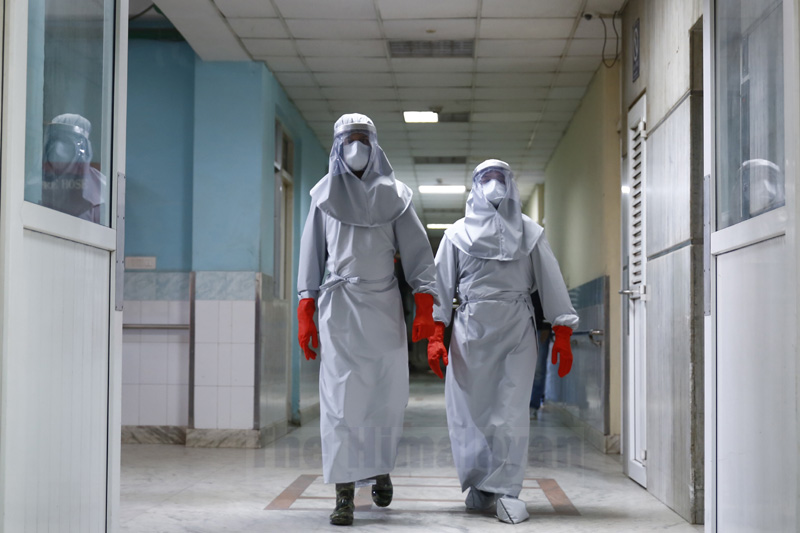Proper testing to contain COVID-19
The first case of COVID-19 in Nepal was detected in January. Since then, more than 1,500 tests have been performed as of April 6. So far, nine persons have tested positive. One has been declared cured, and eight are undergoing treatment at the moment. Most of the samples collected from the contacts and those who meet the criteria for testing have tested negative. In the fast few days, at least three persons have died inside different quarantine/isolation facilities; however, the test results that were reported after their death came out negative.
The National Public Health Laboratory (NPHL), Teku has increased the number of COVID-19 tests performed each day, and majority of the test reports are negative. While this may be good news for the country, many people have started questioning the reliability of the tests performed. The government, however, seems satisfied with its approach and the results till date, importantly with no deaths from COVID-19 within the country.
Scientists and public health experts have raised issue with the molecular test being performed, i.e., the sensitivity and specificity rates and margin of errors. The experts worry about the chances of high false negative rates, taking into account the government’s single-centre testing approach. Members of the public are also concerned about the possibility of widespread ‘hidden cases’, which might not have been screened or diagnosed yet but could be spreading the infection in the families and communities silently.
Many people have recently expressed curiosity about the tests being performed, its technicalities and the final results. As a response, it is the responsibility of the government, stakeholders and individual experts to make the public understand the nature, performance and limitations of the tests. This form of science communication is also important to keep our societies informed and aware of the preparedness and response to the COVID-19 pandemic.
The COVID-19 test currently being performed in Nepal is real time reverse transcriptase PCR (rRT PCR), which is widely used for screening the disease. According to recent data published from China, Europe and the USA, the sensitivity of the test is 60-70%. This means, if the PCR test is offered to 100 confirmed cases, it will detect only 60-70% of the true cases. The remaining 30-40% are considered False Negatives, which means they do have the infection, but the test is simply not showing up. In simple words, there is a chance of missing 30-40% of actually infected cases.
The World Health Organisation has recommended three types of samples for COVID-19 testing: patients’ nasopharyngeal (NP) swabs, bronchoalveolar lavage and sputum. In some centres, clinicians only take either nasal or oropharyngeal specimens instead of taking both. In Nepal, collecting nasopharyngeal samples (or oropharyngeal samples, depending upon the hospital) has been the practice at the time of possible COVID-19 case assessment.
However, according to an original research article, recently published in the Journal of American Medical Association (JAMA), the test positivity rate for PCR (sensitivity) for oropharyngeal sample is just 32% and that for nasal swabs is 63% (Wenling Wang et.al., March 2020). However, the study does not tell about the test positivity for nasopharyngeal, or nasal+oropharyngeal, specimens. This finding of low rates of test positivity suggests that the PCR can miss the infected cases if the appropriate specimen is not taken from the suspected patients.
The PCR test could be negative for a number of reasons. One reason is that the patient may not be infected at all during the time of sample collection, in other words, the patient may not have COVID-19 infection. For those who do not understand science and molecular details of the test, they assume that all suspects with negative tests are truly free of infection.
According to the WHO, the following factors may lead to negative test results while the patient could still be infected with COVID-19: the specimen is of poor quality as there is none or less viral content; specimen was collected very early or late in the infection; the specimen was not handled, stored or transported appropriately; test-specific technical reasons, such as virus mutation or PCR inhibition.
In the case of negative test results in a patient with a high index of clinical or radiological suspicion for COVID-19 infection, the WHO suggests collecting and testing additional specimens from the lower respiratory tract, including, if possible, bronchoalveolar lavage.
In the context of Nepal, some or all of the above factors might have led to the high proportion of COVID-19 negative results, even in clinically suspected cases. As there is no provision of repeat tests for negative results in Nepal, the health care workers at the frontline and close contacts of the suspects should not be fully certain that there is no infection looming around. Instead, these at-risk people should follow extra precautions while dealing with the suspects. The use of personal protective equipment (PPE) is mandatory in addition to the universal precautions at the time of emerging disease crisis in the country.
Those individuals who returned from highly-affected countries, either voluntarily or forcefully, and reached out to the testing centre in the previous weeks to deposit their respiratory samples ultimately found their reports in their favour. Although the returnees have been strictly recommended to stay in quarantine for at least 14 days, they tend to violate the restrictions. The government’s quarantine supervision and monitoring mechanism does not look rigid either, as many of such individuals have been released from quarantine/isolation centres citing various reasons.
To overcome the public’s (false) sense of False Negative test results among suspects and contacts, the National Public Health Laboratory and other authorised laboratories outside the Kathmandu Valley should increase the volume of tests performed each day, regardless of the presence or absence of COVID-19-related symptoms.
A report from Iceland shows that almost half of the infected individuals were asymptomatic. Another way to cover the larger chunk of population for testing is by expanding the testing criteria, for example, by offering community testing, door-to-door testing, and drive-through testing. Even the Director of the WHO has stressed time and often that the best strategy to contain COVID-19 disease is testing, testing and testing.
As a bottom line for success, increasing the number of tests and increasing the scope of testing are important at the current stage as we are lingering ahead of the curve. The government should not miss catching the ‘super-spreaders’ who might be just roaming around in and across the communities, unnoticed by the government’s testing or surveillance mechanism. Repeating the negative tests from the suspects, taking samples from more than one body site, and exploring other methods of tests, such as antibody test (IgG and IgM) and immunoassay tests, might be equally helpful.
Additionally, some studies have shown that combining RT-PCR and Chest CT scan gives better sensitivity and specificity, but the feasibility of chest CT scan in a low-resource setting of Nepal is questionable. With standard procedural measures taken for collection, storage, transport and processing of human samples, there is a chance of reduced errors and less False Negative results.
Last but not the least, the recent decision to introduce rapid tests in a few districts and installation of RT-PCR machines in all the seven provinces of Nepal will certainly help the nation in improving its testing services and catching up with the case diagnosis.
Dr Koirala and Dr Bhattarai are both working on infectious disease research and public health programmes in Nepal and globally
(Disclaimer: The views expressed are personal)






